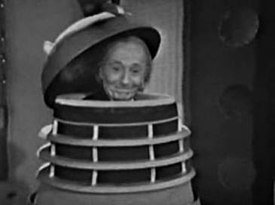
NICHOLAS COURTNEY (1929-2011)
There were few constants in Doctor Who over its original 26-year run. There was The Doctor, of course, the TARDIS, and his companions. However, there was one more, one that occurred quite by accident, but which enriched Doctor Who tremendously: Brigadier Sir Alistair Gordon Lethbridge-Stewart, better known on Earth as Nicholas Courtney. He holds the distinction of having worked on screen with all seven of the original Doctors (albeit briefly with the Sixth in the Dimensions in Time charity special). No other person could or will ever be able to make that extraordinary claim. If one wants to be extremely specific, he worked with a record-eight Doctors if you include audio productions. Again, it's hard to think of people who've worked with more than three Doctors (Elisabeth Sladen comes quickly to mind, but besides her...) Out of all his appearances, it was only with the First Doctor that he did not appear as Colonel, later Brigadier, Lethbridge-Stewart. However, once he became the Brigadier, he found himself one of the most iconic of Doctor Who characters.
His Brigadier was almost, to my mind, a parody of the stiff-upper-lip British soldier, one who had a limited imagination but knew how to fight. His response to any situation can be summed up in Doctor Who & The Silurians, when the Third Doctor (Jon Pertwee) tells his Companion Liz Shaw (Caroline John) something along the lines that it's typical of the military mind--come across a problem and the first reaction is to shoot at it. However strict the Brig may have been when it came to otherworldly aliens, he never seemed shocked by them. Here could come Daleks and Daemons, Yeti and Cybermen, and he would just take it as merely another foreigner attempting to conquer his home. Silly aliens, he might have thought, don't they know we're British?
Still, what could have come off as a strict martinet in Courtney's hands became a likeable, almost lovable, man. It's a testament to Courtney's talents as an actor that the Brig was never mean (even when going against the Doctor's recommendations), or obnoxious. At heart, we always knew the Brigadier meant well, and to use modern parlance, had the Doctor's back. We knew that at the end of the day, he and the Doctor (whomever he was) had a great deal of respect and admiration for the qualities they saw in each other. In short, we could say that the Brigadier was one of the Doctor's friends. They made a wonderful team, and I see this relationship shown best in The Five Doctors. If one thinks about it, the Brigadier should have been furious. Here he is, poor man, at his retirement party, and how does he spend it? In the Death Zone of Gallifrey, trying not to get killed. Does he rage against the Second Doctor (Patrick Troughton)? Does he say, 'I won't have any of this?' No. Like every fine old English (or Scottish) gentleman, he stands shoulder to shoulder with the Doctor, giving all their enemies a right once over. That's the kind of man the Brigadier was, and that's why we loved him.
We also loved the actor as well. Few actors have been so proud to have been associated with a single character as much as Courtney appears to have been. It isn't every day that a truly iconic character in a long-running television show is created. He has that extraordinary legacy, to have known at his death that a role he created was his and his alone. Unlike the various Doctors, no one could ever play the Brigadier. Most actors might have run away from the role, wanted to show they could do more than just that one part. Daniel Craig comes to mind--as (overly) praised as his James Bond is, he is constantly trying to show us how he's an ACTOR by doing all sorts of parts. A more relevant example would be Leonard Nimoy. Nimoy is a good actor (see A Woman Called Golda for proof), but he spent so many years railing against Mr. Spock. Courtney didn't appear to be troubled by being identified as the Brig. You can tell the difference between Nimoy & Courtney merely by their autobiographies. Nimoy called the first volume of his life story, I Am Not Spock. Courtney called his Five Rounds Rapid.
I had always hoped that the Brigadier would have had one last chance to be on Doctor Who, now that the series has been revived successfully. It was a terrible pity that Courtney was not able to reprise his role with either Christopher Eccleston, David Tennant, or Matt Smith. I could understand with the Ninth & Eleventh Doctors, but the Tenth had a good four or five years to where The Brigadier could have come back for one more story. It was good to see him with Sarah Jane in The Sarah Jane Adventures story Enemy of The Bane, but alas, the final call has been made for our beloved Brigadier.
As a Doctor Who fan, I pay my final respects to Nicholas Courtney, for in truth, so long as there are novels and fan fiction and comics, The Brigadier will never truly die. He was, curiously enough, supposed to have died in Battlefield. I don't quite know the reason why he ultimately was spared, and I'd have to watch the episode again to see whether it worked or not. However, it just goes to show you old soldiers truly never die. In the case of Brigadier Sir Alistair Gordon Lethbridge-Stewart, they never fade away either. He shall be in our hearts forever.
Here at Gallifrey Exile, we like to think we keep The Eye of Harmony burning until a New Gallifrey is established. For today, the Eye dims in honour of Nicholas Courtney.
IN MEMORIAM
